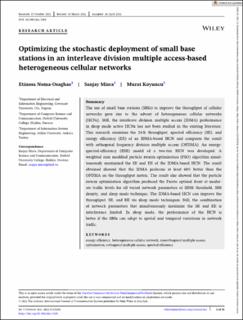| dc.contributor.author | Noma-Osaghae, Etinosa | |
| dc.contributor.author | Misra, Sanjay | |
| dc.contributor.author | Koyuncu, Murat | |
| dc.date.accessioned | 2022-11-14T16:39:13Z | |
| dc.date.available | 2022-11-14T16:39:13Z | |
| dc.date.created | 2022-05-27T18:12:23Z | |
| dc.date.issued | 2022 | |
| dc.identifier.citation | International Journal of Communication Systems. 2022, 35 (12), Artikkel e5204. | en_US |
| dc.identifier.issn | 1074-5351 | |
| dc.identifier.uri | https://hdl.handle.net/11250/3031772 | |
| dc.description.abstract | The use of small base stations (SBSs) to improve the throughput of cellular networks gave rise to the advent of heterogeneous cellular networks (HCNs). Still, the interleave division multiple access (IDMA) performance in sleep mode active HCNs has not been studied in the existing literature. This research examines the 24-h throughput, spectral efficiency (SE), and energy efficiency (EE) of an IDMA-based HCN and compares the result with orthogonal frequency division multiple access (OFDMA). An energy-spectral-efficiency (ESE) model of a two-tier HCN was developed. A weighted sum modified particle swarm optimization (PSO) algorithm simultaneously maximized the SE and EE of the IDMA-based HCN. The result obtained showed that the IDMA performs at least 68% better than the OFDMA on the throughput metric. The result also showed that the particle swarm optimization algorithm produced the Pareto optimal front at moderate traffic levels for all varied network parameters of SINR threshold, SBS density, and sleep mode technique. The IDMA-based HCN can improve the throughput, SE, and EE via sleep mode techniques. Still, the combination of network parameters that simultaneously maximize the SE and EE is interference limited. In sleep mode, the performance of the HCN is better if the SBSs can adapt to spatial and temporal variations in network traffic. | en_US |
| dc.language.iso | eng | en_US |
| dc.publisher | Wiley | en_US |
| dc.rights | Attribution-NonCommercial-NoDerivatives 4.0 Internasjonal | * |
| dc.rights.uri | http://creativecommons.org/licenses/by-nc-nd/4.0/deed.no | * |
| dc.subject | energy efficiency | en_US |
| dc.subject | heterogeneous cellular network | en_US |
| dc.subject | nonorthogonal multiple access | en_US |
| dc.subject | optimization | en_US |
| dc.subject | orthogonal multiple access | en_US |
| dc.subject | spectral efficiency | en_US |
| dc.title | Optimizing the stochastic deployment of small base stations in an interleave division multiple access-based heterogeneous cellular networks | en_US |
| dc.type | Peer reviewed | en_US |
| dc.type | Journal article | en_US |
| dc.description.version | publishedVersion | en_US |
| dc.rights.holder | © 2022 The Authors. | en_US |
| dc.subject.nsi | VDP::Teknologi: 500 | en_US |
| dc.source.volume | 35 | en_US |
| dc.source.journal | International Journal of Communication Systems | en_US |
| dc.source.issue | 12 | en_US |
| dc.identifier.doi | 10.1002/dac.5204 | |
| dc.identifier.cristin | 2027805 | |
| dc.source.articlenumber | e5204 | en_US |
| cristin.ispublished | true | |
| cristin.fulltext | original | |
| cristin.qualitycode | 1 | |

